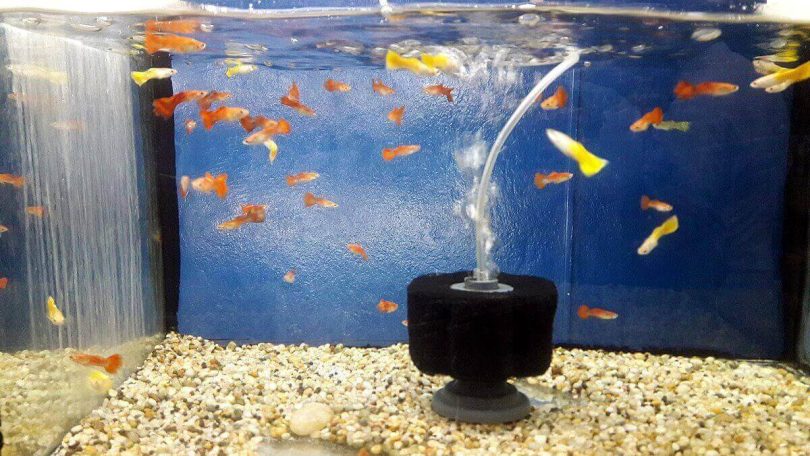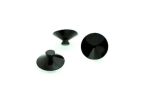Table of Contents
Maintaining a clean and healthy environment for your aquatic pets is crucial to their well-being, and a sponge filter can play a key role in achieving this. However, it’s important to know when and how often to clean your aquarium sponge filter to ensure optimal performance.
In this article, we’ll explore the factors that affect the frequency of cleaning your sponge filter, including the size of your aquarium, the number of fish you have, and the type of filter you’re using.
We’ll also provide step-by-step instructions on how to clean your sponge filter, so you can keep your aquarium clean and your fish happy and healthy.
Understanding Aquarium Sponge Filters
Before we delve into the cleaning routine, let’s quickly go over what an aquarium sponge filter is and how it works. Aquarium sponge filters are simple yet effective mechanical and biological filtration devices.
They are composed of a sponge that provides a large surface area for beneficial bacteria to colonize. As water is drawn through the sponge by an air pump or water pump, the beneficial bacteria break down harmful ammonia and nitrite, converting them into less harmful nitrate.
Sponge filters come in various shapes and sizes, making them suitable for different tank setups and species of fish. They are particularly popular in breeding and fry rearing tanks, as the gentle water flow prevents delicate fish from getting sucked into the filter.
Frequency of Cleaning an Aquarium Sponge Filter
So, how often should you clean your aquarium sponge filter? The answer is not set in stone, as it depends on various factors such as the size of your tank, the number of inhabitants, and the amount of waste produced. As a general rule of thumb, it’s best to check your sponge filter every two to four weeks.
Regular monitoring is essential because overcleaning the sponge filter can disrupt the beneficial bacteria colony, leading to a mini-cycle and an increase in ammonia and nitrite levels.
On the other hand, leaving the filter uncleaned for too long can clog the sponge, reduce water flow, and compromise its filtration efficiency.
Signs Your Aquarium Sponge Filter Needs Cleaning
Now that we’ve established the importance of routine maintenance, let’s discuss some telltale signs that your aquarium sponge filter is due for a cleaning.
1. Discoloration
One of the most apparent signs that your sponge filter needs cleaning is discoloration. If you notice that the once bright and vibrant sponge has turned brown or green, it’s time to roll up your sleeves and give it some attention. The discoloration is primarily caused by the accumulation of organic debris and algae on the sponge’s surface.
2. Reduced Water Flow
A reduction in water flow is another clear indicator that your sponge filter is in need of a good cleaning. As debris accumulates in the sponge, it can obstruct the water’s path, resulting in decreased water circulation. If you notice that the water is not flowing through the filter as efficiently as before, it’s time to take action.
3. Unusual Smells
A healthy aquarium should not emit any foul odors. If you catch a whiff of something unpleasant around your fish tank, the sponge filter could be the culprit.
Organic matter that decomposes in the sponge can produce unpleasant smells, signaling that it’s time to give your filter some much-needed care.
4. High Ammonia or Nitrate Levels
Regularly testing the water parameters in your aquarium is a great habit to develop as an aquarist. If you notice a sudden spike in ammonia or nitrate levels, it might be due to a compromised sponge filter.
The beneficial bacteria might not be functioning optimally, leading to inadequate ammonia and nitrite conversion.
Cleaning Process of Aquarium Sponge Filter
Preparation
Before you begin the cleaning process, it’s essential to gather all the necessary items. You’ll need a clean bucket, aquarium water siphon, and a spare sponge filter (if available).
Having a spare filter allows for a seamless transition during cleaning and ensures the beneficial bacteria colony in your main filter remains intact.
Turn Off the Aquarium Equipment: First and foremost, switch off any equipment connected to the aquarium, such as the air pump or powerhead that powers the sponge filter. This step prevents accidents and keeps your equipment safe during the cleaning process.
Cleaning
Now that you’ve prepared everything let’s dive into the actual cleaning process:
- Remove the Sponge Filter: Gently lift the sponge filter from the aquarium and place it in the clean bucket. Avoid squeezing or wringing the sponge at this stage, as it may damage the beneficial bacteria living inside.
- Rinse the Sponge: Using the aquarium water siphon, rinse the sponge filter thoroughly in the bucket. Be gentle during this step to prevent any disruption to the bacterial colonies. Rinsing with aquarium water helps to retain the essential bacteria while getting rid of excess debris and waste.
- Clean the Sponge Filter: Every few months, or if the sponge appears heavily soiled, it’s a good idea to do a deeper cleaning. Prepare a solution of dechlorinated water from your aquarium and a few drops of mild aquarium-safe cleaner. Soak the sponge in this solution for a short time (about 15-20 minutes) to remove any stubborn deposits. Rinse the sponge thoroughly with aquarium water to ensure no traces of the cleaner remain.
Reinstallation
After the cleaning process, it’s time to put the sponge filter back into the aquarium:
- Replace with Spare Sponge (Optional): If you have a spare sponge filter, now is the perfect time to switch it with the one you just cleaned. This allows you to alternate between filters during cleaning, preventing any potential disruptions to the beneficial bacteria colonies.
- Reattach the Sponge Filter: Carefully place the cleaned or spare sponge filter back into its designated spot in the aquarium. Make sure it fits securely in the filter compartment, so there’s no risk of it floating away.
- Turn On the Equipment: Once the sponge filter is securely in place, turn on the aquarium equipment, such as the air pump or powerhead, to reestablish water flow through the filter. This helps to distribute the beneficial bacteria throughout the tank.
Dangers of Over-Cleaning
As with most things in life, moderation is key. While regular cleaning of the aquarium sponge filter is necessary, over-cleaning can be harmful too. Here are some dangers of over-cleaning your sponge filter:
- Loss of Beneficial Bacteria: The most significant risk of over-cleaning is the potential loss of beneficial bacteria. These bacteria play a crucial role in breaking down harmful ammonia and nitrite into less toxic nitrate, maintaining a healthy nitrogen cycle in your aquarium. If you clean the sponge too frequently or rigorously, you may disturb or eliminate these essential bacteria, leading to an imbalance in the aquarium’s ecosystem.
- New Tank Syndrome: Over-cleaning can lead to what is commonly known as “new tank syndrome” even in an established aquarium. If you remove too much of the beneficial bacteria, the tank’s nitrogen cycle may reset, causing ammonia and nitrite levels to spike. This sudden increase in toxins can stress and harm your fish, potentially leading to illness or even death.
Tips for Maintaining Aquarium Sponge Filters
To ensure your sponge filter functions optimally and provides the best living conditions for your aquarium inhabitants, follow these tips:
1. Regular Check-ups
Keeping your aquarium clean and maintaining a healthy environment for your aquatic friends is essential. One crucial aspect of aquarium maintenance is taking care of the sponge filter.
But the question arises, how often should you clean an aquarium sponge filter? Regular check-ups are key to ensuring that your sponge filter is functioning optimally.
The frequency of cleaning your aquarium sponge filter can depend on various factors, such as the size of your tank, the number and size of your fish, and the amount of waste they produce. As a general rule of thumb, it is advisable to inspect your sponge filter every two weeks.
However, if you have a heavily stocked tank or large fish that produce more waste, you may need to check it more frequently.
During the check-up, observe the sponge closely. If you notice that the pores of the sponge are clogged with debris and waste, it’s time to give it a thorough clean. A clogged sponge can hinder the flow of water and reduce its filtering capacity, which can lead to poor water quality and health issues for your fish.
When performing a check-up, gently squeeze the sponge in a bucket of aquarium water to dislodge any accumulated debris. Never use tap water for this, as it can contain harmful chlorine and chloramines that can harm the beneficial bacteria living in the sponge.
Once the debris is removed, place the sponge back in the filter, and it’s ready to continue its vital job of keeping your aquarium water clean.
2. Use of Aquarium-Safe Products
When it comes to cleaning your aquarium sponge filter, it’s essential to use the right products. Harsh chemicals and soaps can be extremely harmful to the delicate balance of your aquarium’s ecosystem. Instead, opt for aquarium-safe products that are specifically designed for filter maintenance.
One such product is an aquarium gravel cleaner or vacuum. This useful tool not only cleans the substrate but can also be employed to gently clean the sponge filter.
During your regular check-ups, you can use the gravel vacuum to siphon off any debris that has accumulated in the sponge without damaging its structure.
Another aquarium-safe option is using beneficial bacteria supplements. These supplements help boost the colony of beneficial bacteria in the sponge filter, enhancing its biological filtration capabilities.
A well-established colony of beneficial bacteria is crucial for breaking down harmful ammonia and nitrites produced by fish waste.
Remember, never use hot water or any form of soap when cleaning your sponge filter. These can be lethal to the beneficial bacteria, and without them, your aquarium’s ecosystem will suffer.
By choosing the right products and being gentle during the cleaning process, you can maintain a healthy sponge filter and ensure the well-being of your aquatic inhabitants.
3. Avoiding Complete Replacement
One common mistake many aquarium enthusiasts make is replacing the sponge filter entirely too often. While regular maintenance is crucial, a mature sponge filter that has developed a healthy colony of beneficial bacteria is an asset to your aquarium’s ecosystem. Avoid the temptation to replace the sponge at the slightest sign of debris build-up.
Constantly replacing the sponge filter can lead to the loss of beneficial bacteria, which can result in the dreaded “new tank syndrome.”
This phenomenon occurs when the biological filtration is disrupted, leading to an ammonia spike that can be fatal to your fish.
Instead of replacing the entire sponge, consider rinsing it gently with aquarium water during your check-ups. This simple process can remove most of the accumulated debris without disturbing the beneficial bacteria.
Only opt for a replacement when the sponge becomes damaged, disintegrates, or loses its shape, significantly affecting its filtering efficiency.
Another approach to avoid complete replacement is having a spare sponge filter on hand. When it’s time to clean the primary sponge, you can temporarily replace it with the spare one.
This way, you can clean the dirty sponge at your own pace without worrying about harming the tank’s delicate balance.
Remember, maintaining a well-established sponge filter is a vital part of ensuring your aquarium’s water remains pristine and habitable for your fish.
Avoid unnecessary replacements and prioritize gentle cleaning to preserve the beneficial bacteria that play a crucial role in keeping your aquarium healthy.
Conclusion
Congratulations! You’ve successfully learned about the importance of maintaining your aquarium sponge filter, how to identify when it needs cleaning, the cleaning process, and essential tips for proper maintenance.
By regularly cleaning and caring for your sponge filter, you’re providing a clean and safe habitat for your beloved aquatic pets, ensuring they thrive in their underwater paradise. Happy fishkeeping, and may your aquarium be a thriving oasis of aquatic life!







